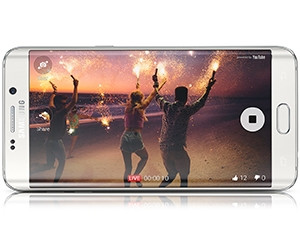
Live broadcasting is a trend that has dominated social media news. It is seen as the next step in the evolution of social media and news consumption.
The term live broadcasting, this year, has taken on a different meaning. It now refers to a mobile user live streaming themselves over video to a private or public audience, through a live broadcasting app such as Periscope or Meerkat. The broadcast happens in real-time and provides the viewer with a first person view of the person or event.
The growing trend has expanded beyond social networks. Samsung announced at the launch of the Galaxy S6 edge plus and Galaxy Note 5 in New York last week that the new smartphones will allow users to live broadcast directly onto YouTube with a feature built natively into the camera.
"It is clear live streaming is going to be the next big growth area," says World Wide Worx MD, Arthur Goldstuck. "Visual media is coming to dominate mobile usage, with both image-based and video-based content accelerating in take-up, and becoming the preferred medium for content, especially among younger users.
"We will see many more innovations in how content is delivered to or from phones in the coming years, as it will be seen as an opportunity for differentiation in an environment where the physical form factor provides ever-decreasing opportunities for doing so. Visual content will be the key battleground, and Samsung is treating it as a priority area."
40 years a day
The first live broadcasting app, Meerkat, was launched at the South by Southwest conference in Austin, Texas early this year. And Facebook recently announced it will be expanding its own live broadcasting feature to verified profiles.
Last week, Twitter-owned Periscope announced it had over 10 million accounts on the platform, only four months after launch. As of the beginning of August, 40 years of video was being watched each day.
TheNextWeb journalist, Owen Williams, described Periscope in an article as: "It's almost like next-level Twitter. Information starts flowing in and you can experience it as it happens, in real-time. With Periscope, you get a whole new level of access to the events unfolding on the ground."
Mike Sharman, owner of digital agency, Retroviral, says: "Social media has given people access to immediacy of events for years. Live broadcasting does this visually; it is a natural progression, giving the viewer a fully immersive experience and context of the event."
Mobile experience company
Goldstuck says there is no longer such a thing as a handset company. "Any manufacturer of smartphones has to see itself as a mobile experience company, and the mobile experience is no longer only about the handset."
"The app, content and experience ecosystem built around the handset will drive its uptake. Companies like Samsung have been involved in content since they began producing data devices; the content has merely moved to the centre rather than being peripheral."
Users of the new Samsung feature will be able to broadcast private streams that are invite-only or broadcast publically. It can stream up to 1 080p with a resolution of 60fps, and users have the ability to make use of both the front and back cameras. Live broadcasts will also be saved for viewing later on YouTube channels.
Periscope broadcasts only last 24 hours after streaming and are only accessible to those with a Twitter account. Meerkat does not offer an option for replay after the broadcast has finished. Broadcasts on Facebook are live after streaming, embedded on the platform.
The ability to stream directly to YouTube has been touted as a 'game-changer', however, Goldstuck says this is nothing more than "PR hype".
"Samsung's live streaming on YouTube is an evolution of the kind of live streaming that is already available on YouTube and Google Hangouts. It simplifies the process, and makes it available to any phone users, rather than only to those with the right technical knowledge and facilities.
"It also means that it does not require one to download a specific app, like Meerkat or Periscope, in order to view live streaming on a phone. This means that, while it is not a technological breakthrough, it could have a major experiential impact," says Goldstuck.
Business applications
Sprout Social said there were four reasons businesses should pay attention to the live broadcasting trend and why it would be useful to take advantage of:
1. Immediate response
Businesses can do real-time damage control and engage in 'face-to-face' conversation through live broadcasting. Businesses also have the opportunity to instantly weigh in on timely topics.
2. Faster production:
Live broadcasting does not require preparation, editing or packaging.
3. Broader reach
Anybody can tune in to a live broadcast, eliminating the need to have all stakeholders in the same room.
4. Mobile friendly
Live broadcasting audiences will mostly be watching from a mobile device which is more accessible and universal.